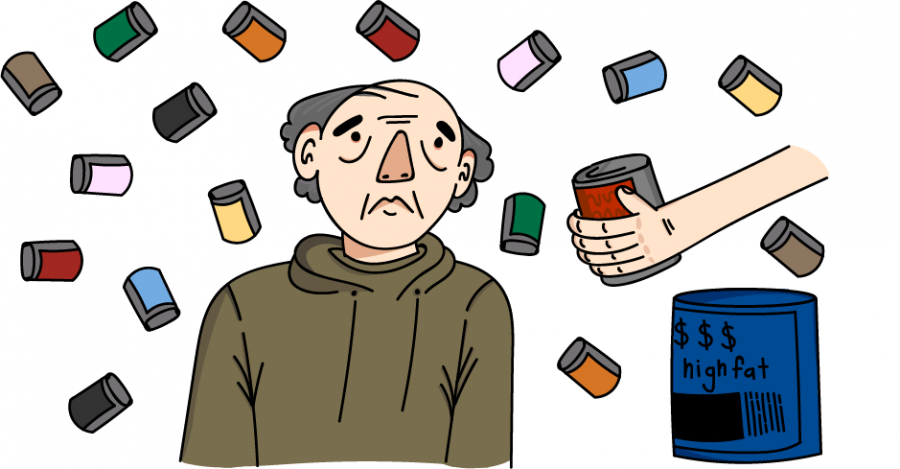Canned Food Drives CAN’t Solve America’s Hunger Crisis
13.4% of citizens in California lack enough resources to meet basic needs, according to the Public Policy Institute of California.
Slimy peas, salty beans and preservative-packed cranberry sauce are just some of the foods donated during the holiday food drive season. Portola students collected over 200 cans for the Second Harvest Food Bank in Irvine this year, according to ASB teacher Emily Sheridan. Despite the genuine intentions to provide food for those in need, canned food drives do not serve as the most effective solution for hungry families. Instead, Portola should use fundraisers to collect cash donations, which would supply more people with high-quality food.
The issue of the canned food drive begins with the grocery store, where customers will purchase canned foods at a retail price several times their actual value. For example, the Calgary Food Bank promises that every $1 donated can be turned into $5 worth of food; in other words, every dollar spent on a food item at Target or Walmart could instead be donated and multiplied by a food bank that has direct access to a manufacturer.
According to Colby Itkowitz from the Washington Post, “Because food banks can also purchase food wholesale at a significant discount, most would prefer cash over food donations because they can stretch that money further, and it’s far less labor-intensive than sorting cans.”
Even worse is the donor who takes their unwanted, leftover canned food after Christmas to the donation bin, expecting another family to enjoy it. While one man’s trash may be another man’s treasure, the same principle does not apply to food waste.
When this jumble of random cans makes its way to the food bank, it is sorted, stored and inventoried. But during this process, around half of all food is discarded as inedible or undesired, according to Katherina Rosqueta, director of the Center for High Impact Philanthropy at the University of Pennsylvania.
Nonperishable foods typically contain artificial ingredients, meaning that they do not provide enough nutrition to sustain a well-balanced diet. A healthy meal plan includes fresh foods that are not packed with preservatives, which food banks can supply much more consistently than donors can. Health issues can also prevent individuals from eating commonly-donated foods.
“For example, if a member of the family has high blood pressure, that person cannot eat high sodium canned soup or packaged ramen noodles,” Rosqueta said in an interview with the LA Times. “If a child has a nut allergy, that child may not be able to eat packaged food containing nuts or processed in a facility with nuts.”
Although organizations host food drives primarily around the holiday season, many people do not realize that food insecurity in less-affluent communities is a year-long struggle. Food-insecure individuals do not have reliable access to a sufficient quantity of affordable, nutritious food. More than 37 million people nationwide struggle with food insecurity, including over 11 million children, according to Feeding America.
Those in favor of food drives argue that charities will misuse monetary donations by pocketing the cash instead of giving back to the community. While it is true that this behavior is present in less-trustworthy organizations, any risk can easily be eliminated through research. For example, charities like Feeding America and Oxfam America are reputable, national organizations that have existed for decades. Many local food banks also have separate bank accounts for the sole purpose of purchasing food, which ensures that funds are not withdrawn for other purposes, according to an NPR interview with Rosqueta.
While it may be a heartwarming experience to put that can of Spam in your school’s donation bin, impoverished families need more than just the seasonal fundraiser. Students who come from food-secure households need to recognize their privilege and do what they can for those in need year-round.
If you’re still searching for that sweet, sweet physical validation, try spending the day at a local food bank. Volunteering at a soup kitchen is inarguably more fulfilling than simply tossing chicken soup into a box. If your school or local community organization wants to host a unique fundraiser, try finding creative ways to have people give money while still making the experience engaging. Encourage donors to attach a note or letter to their donation, which allows them to form a personal connection with the cause. Organizations can also replace food drives with bake sales or live entertainment, from which a percentage of the profit would be donated. Fundraisers like these can take place at any time of year, helping food banks avoid the traditional overflow of canned goods during the holidays. Communities will benefit more from cash donations than they would from any canned vegetables.
Your donation will support the student journalists of Portola High School. Your contribution will allow us to purchase equipment and cover our annual website hosting costs.

Bia Shok is the co-news editor for her third and final year on the Pilot! She is super excited to expand the Pilot’s influence even further this year...

Lauren Hsu is your Opinion Editor and Co-Social Media Manager for her third and final year on the Pilot staff. She is looking forward to making even more...

Nate Taylor is the 2021-22 front page editor and photo editor. He is ready to improve his design skills and create memorable Portola Pilot front covers....





